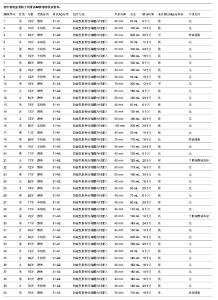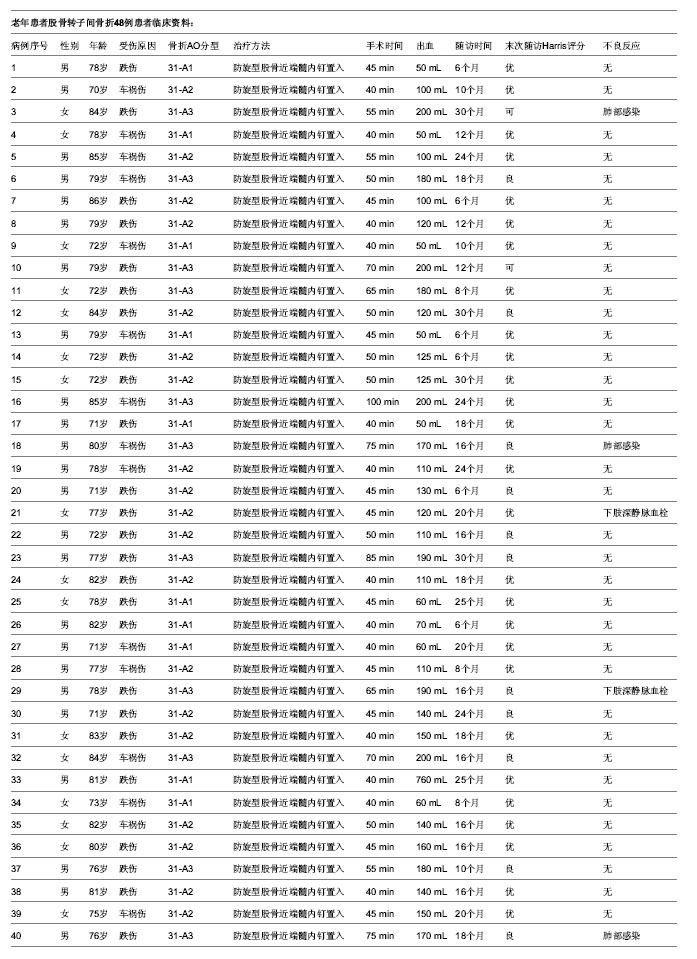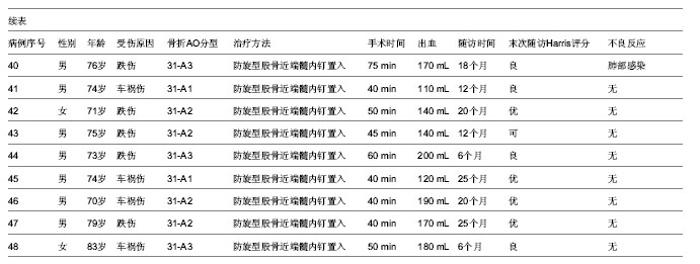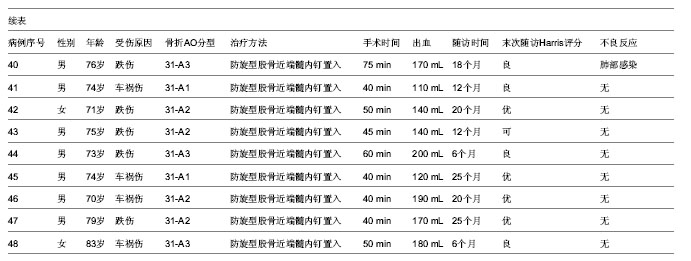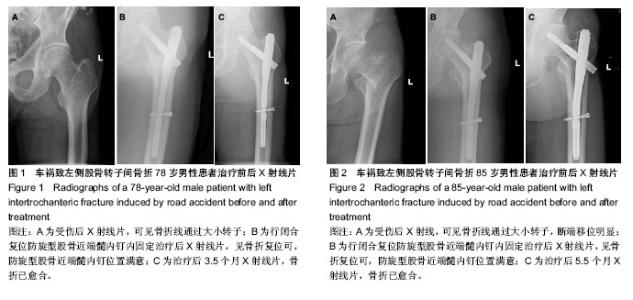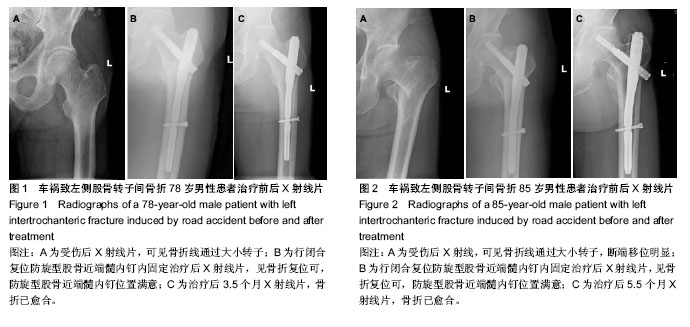| [1] 苟三怀,王琪,刘岩,等.股骨转子间骨折的治疗方法选择(附1037例分析)[J].中华创伤骨科杂志,2007,9(4):319-322.
[2] Casaletto JA,Gatt R.Post-operative mortality related to waiting time for hip fracture surgery.Injury.2004; 35(2): 114-120.
[3] 冯明利,沈惠良,雍宜民.影响股骨转子间骨折疗效相关因素分析[J].中华创伤杂志,2003,19(2):80-82.
[4] 张绍安,魏新军,贺喜顺,等.股骨近端防旋髓内钉治疗股骨转子间骨折的临床应用[J].中国现代医生,2013,51(11):143-145.
[5] 张绍安,魏新军,郑水长,等.微创PFNA内固定联合鲑鱼降钙素治疗老年股骨转子间骨折[J]. 中外医疗,2013,32(13):75-76.
[6] 刘建.股骨近端防旋髓内钉(PFNA)联合抗骨质疏松治疗老年股骨转子间骨折69例临床报告[J].中外医疗,2013,32(34):84-85.
[7] 余昆洪,刘松.PFNA治疗股骨粗隆间骨折伴严重骨质疏松症22例疗效分析[J].医学信息, 2013,27(28):663.
[8] 邱志杰,徐红革,王良恩,等.PFNA治疗老年患者不稳定股骨转子间骨折疗效及并发症分析[J].中外健康文摘,2012,9(27):224- 226.
[9] Ekstrom W,Karlsso n-Thur C,Larsson S,et al.Functional outcome in treatment of unstable trochanteric and subtrochanteric fractures with the proximal femoral nail and the Medoff sliding plate.J Orthop Trauma.2007;21(1):18-25.
[10] Helwig P,Faust G,Hindenlang U.Finite element analysis of four different implants inserted in different positions to stabilize an idealized trochanteric femoral fracture.Injury. 2009;40(3):288-295.doi: 10.1016/j.injury.2008.08.016.
[11] Vidyadhara S,Rao SK.One and two femoral neck screws with intramedullary nails for unstable trochanteric fractures of femur in the elderly–randomized clinical trial.Injury. 2007; 38(7):806-814.
[12] Strauss E,Frank J,Lee J. Helical blade versus sliding hip screw for treatment of unstable intertrochanteric hip fractures:A biomechanical evaluation.Injury. 2006;37(10): 984-989.
[13] Parker MJ, Handoll HH. Gamma and other cephalocondylic intramedullary nails versus extramedullary implants for extracapsular hip fractures in adults.Cochrane Database Syst Rev.2010;(9):CD000093.
[14] Miedel R, Ponzer S,Törnkvist H,et al.The standard Gamma nail or the Medoff sliding plate for unstable trochanteric and subtrochanteric fractures.A randomised, controlled trial.J Bone Joint Surg Br.2005;87(1):68-75.
[15] Hu SJ,Zhang SM,Yu GR.Treatment of femoral subtrochanteric fractures with proximal lateral femur locking plates.Acta Ortop Bras.2012;20(6):329-333.
[16] Ruedi TP,Buckley RE,Moran CG.AO Principles of fracture management.Davos,AO Publishing,2007:560-598.
[17] 戴兵,盂祥德,骆洪涛,等.三种手术方法治疗老年股骨转子间骨折的疗效比较[J].中华创伤骨科杂志,2010,12(7):688-690.
[18] Baumgaertner MR,Curtin SL,Lindskog DM,et a1.The value of the tip-apex distance in predicting failure of fixation of peritrochanteric fractures of the hip. J Bone Joint Surg Am. 1995;77(7):1058-1064.
[19] PFNA.Leading the way to optimal stability:Synthes.Original instruments and implants of the Association for the study of internal Fixation Fixation.AO/ASlF.Strate Medical,2004:1-44.
[20] Gasaletto JA,Gatt R.Post-operative mortality related to waiting time for hip fracture surgery.Injury.2004; 35(2): 114-120.
[21] 郭世绂,罗先正,邱贵兴.骨质疏松基础与临床[M].天津:天津科学技术出版社,2001:330-428.
[22] Mereddy P,Kamath S,Ramakrishnan M,et a1The AO/ASIF proximal femoral nail antirotation (PFNA): a new design for the treatment of unstable proximal femoral fractures.Injury. 2009;40(4):428-432.
[23] 张殿英,姜保国,付中国,等.防旋型股骨近端髓内钉治疗转子间骨折的初步疗效分析[J].中华创伤杂志,2007,23(2):91-93.
[24] 邓建龙,王剑敏,张茗慧,等.股骨近端防旋髓内钉治疗不稳定转子间骨折[J].实用骨科杂志,2012,18(1):55-57.
[25] 杨正刚,郭强.闭合复位Gamma钉内固定治疗老年性股骨转子间骨折[J].局解手术学杂志,2009,18(4):240-241.
[26] 王纪亮,杨晓红,赵雨千.可膨胀髓内钉治疗股骨转子间骨折的临床分析[J].局解手术学杂志,2011,20(2):166-168.
[27] Zhou F,Zhang ZS,Yang H,et al.Less invasive stabilization system (LISS) versus proximal femoral nail anti-rotation (PFNA) in treating proximal femoral fractures:a prospective randomized study. J Orthop Trauma.2012;26(3):155-162.
[28] Kammerlander C,Gebhard F,Meier C,et al.Standardised cement augmentation of the PFNA using a perforated blade: A new technique and preliminary clinical results. A prospective multicentre trial.Injury.2011;42(12):1484-1490.
[29] 张国鑫,申海波,高志学,等.股骨近端防旋髓内钉治疗老年股骨转子间骨折[J].实用骨科杂志,2009,15(11):820-823.
[30] 陈天均,李登学.股骨近端抗旋髓内钉治疗老年股骨粗隆间骨折[J].局解手术学杂志,2011,20(5):524-525.
[31] 郭庆三.老年股骨粗隆间骨折手术治疗的合理选择[J].局解手术学杂志,2010,19(6):453-454. |
